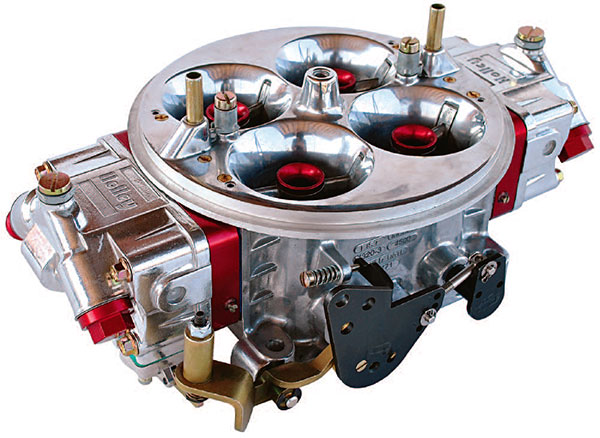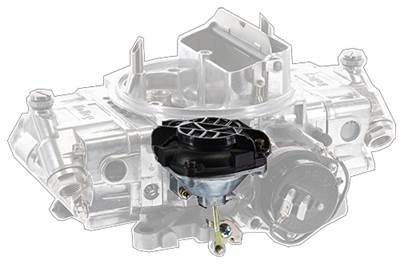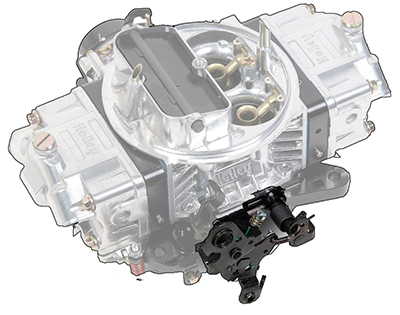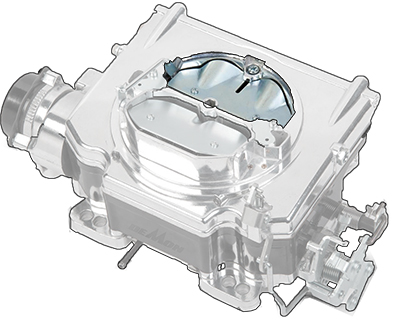
(Image/Car Tech Books)
There is much to consider when choosing a carburetor for your vehicle.
Airflow, choke style, and even the physical height of your carburetor will come into play.
But what about the barrels? How do they work? And what type of secondaries do you want?
Here are the basics you need to know about primary and secondary barrels.
What’s the Difference Between a Carburetor’s Primary and Secondary Barrels?
A four-barrel carburetor has two primary and two secondary barrels.
At idle and low-rpm driving, only the primary barrels open. The throttle blades on the secondary barrels stay closed.
As rpm increases, the engine requires more air and fuel to make power, and this is when the secondary barrels kick in. As the secondary barrels begin to open, more air travels through the carburetor, supplying the engine with the air and fuel it needs.
What are the Different Secondary Types?
Vacuum Secondary

The secondary blades are attached to a vacuum diaphragm by a rod. As rpm increases, so does the vacuum in the intake manifold. The added vacuum moves the diaphragm. This moves the rod and opens the secondary throttle blades.
Mechanical Secondary

These secondaries open with a mechanical linkage. The more you push the pedal, the more they open.
Air Valve

These secondaries have an air valve, similar to a choke blade, above the barrels. As engine vacuum increases, it opens the air valve. Some air valves are counter weighted. Others are controlled by a spring.
How Do the Different Secondary Styles Affect Performance?
It is important for the secondary barrels to open at the right time. It is also important that they open at the optimum rate to precisely meter the air and fuel the engine needs.
If they open too slowly—or too late—it will starve the engine of air and fuel. The end result is less top end power.
If they open too fast—or too soon—the engine will get bogged down. This lets in too much air and not enough fuel. This lean condition will result in poor throttle response and slow acceleration.
Vacuum Secondary Carbs are a good choice for street cars. Because they are controlled by vacuum, they respond automatically to the engine’s needs. Adjusting the secondaries is as easy as changing the spring inside the diaphragm.
Mechanical Secondary Carbs are used in race cars that operate at max throttle. They can also be used to give the driver more control. Tuning the accelerator pump is required to prevent a bog. This is more complicated than a simple spring change.
Air Valve Carbs provide the best throttle response on street cars. Air valve-style carbs with counterweighted doors aren’t adjustable. However, adjusting a spring-controlled air valve is as simple as turning a screw.

“As rpm increases, so does the vacuum in the intake manifold. The added vacuum moves the diaphragm. This moves the rod and opens the secondary throttle”. Not totally accurate. As RPM increases air VELOCITY INCREASES through the venturi and manifold vacuum decreases. This increase of velocity across the venturis results in a greater vacuum on the outlet side of the venturi which is internally routed to the secondary throttle blade actuating chamber working against SPRING pressure. As vacuum within the chamber overcomes spring force, the associated linkage will cause the secondary blade(s) to progressively open. This allows air into the manifold via the secondary venturis which contain the necessary openings to admit fuel into the air stream and into the engine. It is the venturi effect which powers the vacuum secondaries and the fuel flow into the engine. It is the science of fluid power.
Yes, the Holley secondary diaphragm is controlled by the vacuum signal at a small port in one of the primary venturis. As air velocity increases through the primaries, the vacuum signal across the port becomes stronger, so it pulls harder against the diaphragm spring.
As cfm increases so does price. why?
Because it can and will , bigger carb means bigger money to build and carb makers want their big cut also. Its cubic dollars that make a car fast !
[…] powerful V8 model, then you can either go for the Holley 0-1850sa or Holley 0-80457S. Both these carburetors offer 4-barrel functionality, letting you accelerate your car. Additionally, the aluminum body […]
how can i buy those type of carburetor ????????????
Not sure if this the right place to ask, but I’ll try anyway.
If the mixture delivered by the carb is always stoichiometric, it always contains the same ratio of fuel:air, irrespective of the accelerator position. Does that mean that the accelerator only controls what percentage of the cylinder is filled with mixture?
So, wide-open throttle is when 100% of the cylinder is filled with fuel/air?
(Sorry for asking such a dumb question)